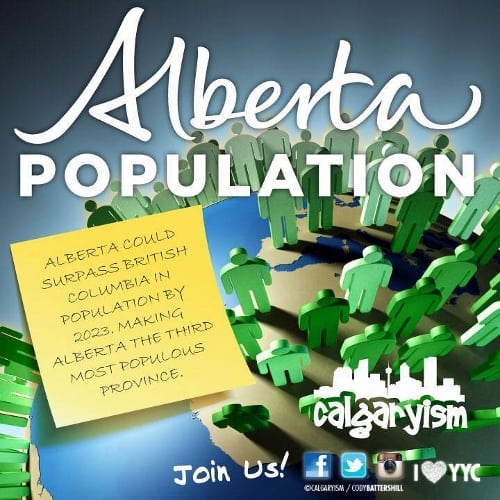Alberta’s Population Just Keeps Growing, and Growing…
- July 12, 2014
- By Cody Battershill
Alberta Population Predictions Show Lots of Growth to Come...
Alberta could surpass British Columbia in population by 2023, making it the third most populous province in Canada.
According to Statistics Canada (2011), the current population demographic between the provinces is:
#1 – Ontario – 38.4%
#2 – Quebec – 23.6%
#3 – British Columbia – 13.1%
#4 – Alberta – 10.9%
#5 – Manitoba – 3.5%
#6 – Saskatchewan – 3.1%
#7 – Nova Scotia – 2.8%
#8 – New Brunswick – 2.2%
#9 – Newfoundland and Labrador – 1.5%
#10 – Prince Edward Island – 0.4%
#11, 12, 13 – Northwest Territories, Yukon and Nunavut – 0.1% each
A majority of Canada’s population currently resides close to the United States border in the top four provinces listed above – they account for nearly 86 percent of all Canadians!
On the other hand, the Northwest Territories, Yukon and Nunavut hold more than one third of Canada’s total land mass but only account for 0.3 percent of its population!
Future Estimates 
In 2041, Alberta will have 2.2 million more people living within its borders, up from its current population of 4 million to 6.2 million.
Approximately 44 percent or 915,000 of those 2.2 million people will be a result of inbound international migration. Around 25 percent, or just over 500,000 will be due to inbound migration from other Canadian provinces.
A majority of those international migrants are expected to be younger and impact the provincial birthrate, further increasing growth over the given time frame.
Between 2013 and 2041, the annual growth rate is estimated at 1.6 percent - just shy of that between 1983 and 2013 at 1.7 percent.
In 2025 Alberta’s population is expected to reach the 5 million mark.
The average age will increase by five years from 36 years today to 41 years in 2041.
A majority of that population gain will be seen along the Calgary-Edmonton corridor as well as in these two major urban centres.
Most international and provincial migrants end up in either Calgary or Edmonton – about 90 percent.
Other Fun Facts
- On the typical day in 2013 in Alberta, about 62 people pass away and 147 new babies are born.
- In 2041, those numbers will change to 129 and 194 respectively.
- Work age percentage, or people between 15 and 64, was around 71 percent of the total provincial population in 2013.
- That number is expected to drop to 64 percent by 2041.
- Canada’s population has never experienced a population decline since its establishment in 1867.
Factors Involved
Alberta’s economy has continued to perform well even through times of economic turmoil in other parts of Canada and the world, attracting many in search of new jobs and a better way of life.
Strong employment growth has kept up an appealing job market while average household incomes are the highest in the country.
In addition, opportunities in the oil and gas, forestry and agricultural sectors has led to robust growth over the short term in otherwise remote locations such as Fort McMurray, Grand Prairie and other industry-related hot spots around the province, as well as in major urban centres.
*Sourced from Alberta Population Projects by Census Divisions, 2014 - 2041
Find out more about our provinces population growth today…
Join Us
Want to know more awesome facts about Calgary, Alberta and Canada as a whole? Join us today at Calgaryism on Facebook, Instagram and Twitter and stay connected with live feeds via social media… we hope to see you there!




